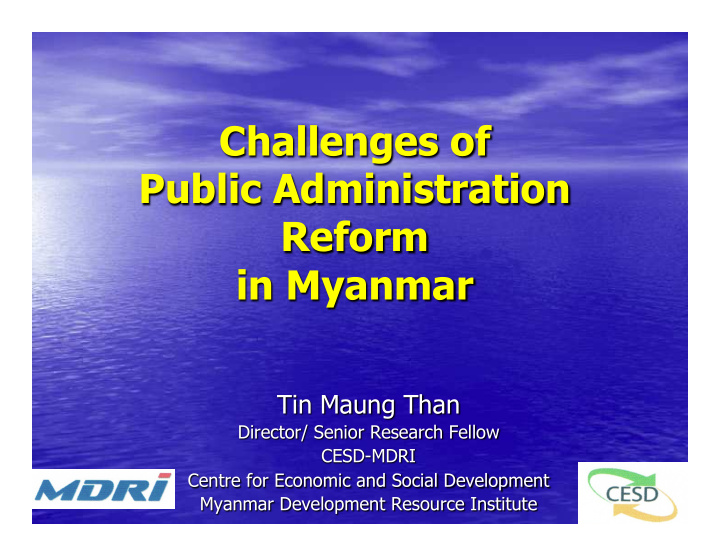



Challenges of Public Administration Reform in Myanmar Tin Maung Than Director/ Senior Research Fellow CESD-MDRI Centre for Economic and Social Development Myanmar Development Resource Institute
Is Myanmar too ambitious? • Transition to Democracy • Transition to Peace • Transition to Market Economy • Transition to Good Governance
The Context 2008 Ethnic Issue & Military in Constitution Politics Personal Interests/ Distrust/ Defensive New Government: Previous Regime President +10 ministers Psychology Low Salary/ Low Morality/ Corruption Discretionary Power Military Organizational Command Culture: Top Down & No & Loyalty Political Insulation Loyalty > Meritocracy Ex-military officers in Above Assistant Director bureaucracy level
Political Vision and Agenda in President’s Speeches • Politics: Peace, liberalization and transition to democracy • Economy: Market Economy – Macroeconomic fundamentals: Inflation stability and exchange rate reform – Open Market: sim card 1.5 $ down from $ 5000 • Import Liberalization: Car import • Export Oriented: Garment industry • Development: people centered development • Administration: Good Governance, Clean Government 4
Reform: from a key PO minister’s presentation to local & regional authorities POVERTY ALLEVIATION RURAL DEVELOPMENT ADMINISTRATIVE PRIVATE SECTOR DEVELOPMENT ECONOMIC POLITICAL GOOD GOVERNANCE CLEAN GOVERNMENT
Approach: Domestic + International/ Across Ministries + Individual Ministries Across Ministries thru Five Programs • International Participation 1. OGP (Open Government Partnership) + Egovernment 2. EITI (Extractive Industry Transparency Initiative) • Domestic Initiative 3. Reducing red tape linked to WB’s Doing Business Report, yet far distant to be called regulatory reform 4. Decentralization: Administrative adjustment to 2008 constitution 5. To adopt the Civil Service Competency Framework for capacity building and restructuring 9
Approach: Domestic + International/ Across Ministries + Individual Ministries • Individual ministerial reform • Public finance management (Finance Ministry) • Comprehensive Education Sector Reform (Education Ministry - CESR) • Corporatization (eg., telecommunication, airline) 7
Reality Check on Six Dimensions: Myanmar’s Governance Indicators http://info.worldbank.org/governance/wgi/sc_chart.asp Standard Error: 0.15 to 0.33 Indicators (Percentile Rank) 1996 2000 2005 2010 2011 2012 2013 Voice and Accountability ¡ 1.4 ¡ 0.5 ¡ 0.0 ¡ 0.9 ¡ 2.8 ¡ 4.3 ¡ 6.6 ¡ Political Stability and Absence of Violence/ 10.1 ¡ 6.7 ¡ 20.2 ¡ 10.8 ¡ 14.6 ¡ 18.0 ¡ 13.3 ¡ Terrorism ¡ Government Effectiveness ¡ 6.3 ¡ 8.3 ¡ 3.4 ¡ 2.4 ¡ 3.3 ¡ 3.8 ¡ 4.3 ¡ Regulatory Quality ¡ 3.9 ¡ 2.9 ¡ 1.5 ¡ 1.0 ¡ 1.4 ¡ 1.9 ¡ 5.3 ¡ Rule of Law ¡ 6.7 ¡ 9.6 ¡ 2.4 ¡ 2.8 ¡ 3.8 ¡ 6.2 ¡ 10.9 ¡ Control of Corruption ¡ 2.9 ¡ 4.4 ¡ 1.0 ¡ 0.5 ¡ 0.5 ¡ 11.5 ¡ 12.4 ¡
Structural Change: Permanent Secretary Minister Deputy Minister Permanent Secretary Statistics & Policy, Domestic/ Finance & Administration Planning Regulatory Foreign & HR Internal Review, Relation & Audit Monitoring & Media Evaluation Relation
Major Institutional Challenges • Leadership § political will: yes at top but weak at multilevel § vision: vague and not shared • Authority Structure: silos in nature (from military command?) • Bureaucracy disempowered § No separation of political and bureaucracy level • Reform not grounded on coherent technical and contextual assessment and knowledge § Lack of overall public sector structural assessment § Lack of Assessment in all areas § “Our problem is lack of knowledge of how to change” (one of the rectors)
Challenges • Weak core values of good civil service: merit, competence, continuity, political insulation & accountability • Co-ordination: several committees but weak in implementation • Unable to adopt “whole-of-government” approach yet in administrative simplification – Need to develop an organization like • Local Better Regulation Office in UK, Danish Evaluation Institute for Local Governments in Denmark, Kafka department in Belgian (Administrative Simplification) • Institutional Development Programme (IDP) in Egypt, Cabinet Implementation Unit in Australia (to set well defined target, accountability)
Challenges • Limited resource available • E-government in initial stage • Rent seeking and corruption • Standardization of procedures: lack of standardization promotes discretion leading to corruption • Low capacities and skills • Measurement and evaluation: lack of clear objectives and targets
Thanks Questions?
Recommend
More recommend